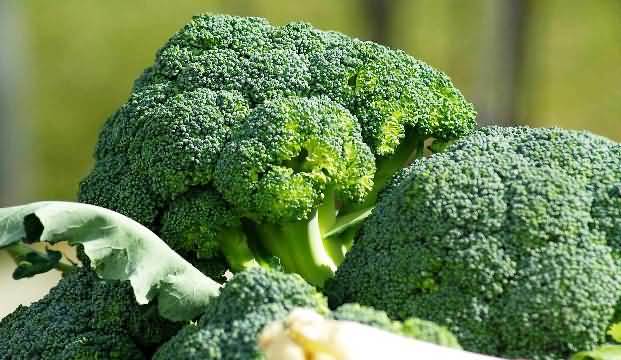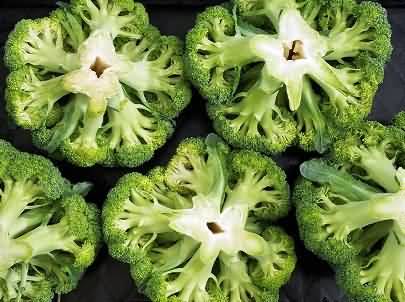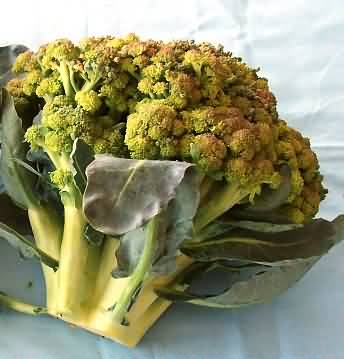स्प्राउट ब्रोकोली: छत्तीसगढ़ सब्जी उत्पादन में रिवोल्यूशनरी उद्यम
Sprout broccoli belongs to cruciferae family. Its botanical name is B. oleracea L. var. italica . Due to its cauliflower like appearance, sprouting broccoli or broccoli in the local parlance is known as ‘Hari Gobhi’, meaning green cauliflower. Broccoli with purple and white heads is grown in Italy. Broccoli is an Italian word, derived from the Latin branchium, meaning anarm or branch.
Broccoli has two distinct forms. One makes a dense, white curd like that of cauliflower and is called ‘heading broccoli’. The other makes a somewhat branching cluster of green flower buds atop a thick, green flower stalk. Small axillary heads/ sprouts arise from the stem at leaf axils. This form is called ‘sprouting broccoli’.
Broccoli is an important vegetable among the Cole crops. It is a rich source of vitamins and minerals. In fact, it contains more vitamin A than cabbage and cauliflower and the highest amount of proteins among the Cole crops. It also contains anti-cancerous compounds and antioxidants.

Broccoli is an excellent source of vitamins A and C and also a good source of folate. Dark green colour of broccoli is an indicator of its rich carotene content. Sulforaphane, indoles, β-carotene and phytochemicals, found in broccoli, are reported to have anti cancerous properties.
Broccoli is also reported to have medicinal properties to cure heart ailments and diabetes. Broccoli also contains certain amount of goitrogens, the naturally occurring substances that can interfere with the functioning of thyroid gland.
However, cooking helps to inactivate such compounds. Per 100 g edible part, broccoli contains 89.1percent moisture, 3.6 g protein, 0.3 g fat, 5.9 g carbohydrates, 2500 IU vitamin A, 0.10 mg thiamin, 0.23 mg riboflavin, 0.9 mg niacin, 113 mg Vitamin C, 103 mg calcium, 78 mg phosphorus and 1.1 mg iron.
Varieties of Broccoli
Green sprouting broccoli having green, firm and compact crown heads are more in demand in India. The improved available varieties for various regions of India are as follows:
1. Pusa Broccoli Kt. Sel. 1 (IARI, Katrain)
It is developed by selection from the exotic material. The heads are compact, light green, each weighing 250-400 g. It takes 85-95 days to reach marketable maturity.
2. Palam Samridhi (CSK HPAU, Palampur)
It is developed by selection from the exotic material. Its heads are medium sized, compact, each weighing 300-400 g. Heads are ready for harvesting 85-90 days aftertransplanting. Average yield is 150-200 quintals per hectare.
3. Palam Kanchan (CSK HPAU, Palampur)
It has been developed by selection from the exotic material. The heads are large, compact, attractive and yellowish-green in colour. Harvesting is possible 140-145 days after transplanting. Average yield is 250-275 quintals per hectare.
4. Punjab Broccoli No. 1 (PAU, Ludhiana)
It is developed by selection from the exotic material. The leaves are small, wavy and dark green. The heads are compact and dark green with bluish tinge. It is early maturing and takes65 days to reach marketable maturity. Average yield is 175 quintals per hectare.
Some other important varieties are: Solan Green, Lucky, Pushpa, Aishwarya, Palam Vichitra. After the very curious and specific research, two varieties are developed for northern hill zone of Chhattisgarh viz. Palam Samriddhi and KTS-1.
Climate of Broccoli
Broccoli is grown as a winter crop in most parts of India. However, in higher hills it is grown as a spring-summer crop. Exposure to high temperature during development stage of heads induces bracts and deteriorates quality of heads.
A temperature of 20-22°C is considered optimum for proper growth and development. It can tolerate short spells of frost. However, temperature below –4°C damages or kills the plants.
On the other hand, exposure to temperature higher than 27°C during curd development causes discoloration of curds and pre-mature flowering. For excellent germination, the ideal soil temp should be around 20 °C to 22 °C.
Broccoli can be grown in a wide variety of soils, but sandy and silt loam soils are most suited. It prefers well-drained upland soil for proper growth. The optimum pH range is 5.8- 7.2.
Field preparation
Land preparation also plays a very important role in the commercial broccoli cultivation. So, bring down the soil in fine tilth form by giving two or three plowing before planting. Extra weeds should be removed along with other dead material from the field.
For single row planting on raised beds, furrows of 0.5 meter apart should be made, whereas, for double row planting, it should be 1.0-meter-wide and 0.5 meters apart.
Before Planting broccoli, Land is plowed 3-4 times, then add compost or well rotten FYM 25-30 tons/ hectare and mix thoroughly at the time of land preparation.
Propagation in Broccoli Farming
Propagation in Broccoli vegetable farming is mainly done by seeds. It can be achieved by direct seeding on the main field. Or by transplanting the seedlings, grows on nurseries beds on the field. Presently, Modern farmers used to grow broccoli seedling, raised in nurseries using the cell trays. About 500 g seed is sufficient to raise nursery for one hectare.
Preparation of Nursery
- Prepare 1 meter wide and 3 meters long and 30 cm wide soil bed.
- Mix roughly 10 kgs of good F.Y.M or compost manure into the soil in each bed. Likewise, add 50 grams of foret and 100 gm of Bavistin powder each spring and mix them in soils.
- Then make 5 cm parallel to the 2 cm deep line’s width on the bed and sow broccoli seed. After that, cover the seeds with fine compost material.
- Provide light water with the help of a sprinkler.
- For one hectare, broccoli cultivating hybrid seeds requires approximately 312 grams.
- Seed germination starts after 5 to 6 days, and seedlings and ready for transplantation within 35 days.
- At this time the transplantation, the broccoli plant must have 4-5 leaves.
- The best time sowing of seeds is the second week of September.
- During plant growth, the temperature should be 20° C to 22 ° C.
- For better growth for the seedlings, the ideal night and day temperature is 20° C to 23° C
- While giving water to the nursery, Give quantity to be calcium nitrate and potassium nitrate, should be given to the plants mixed with 1.5 liters of water in one liter of water.
- Similarly, every 10-12 days of malathion or disease should be prevented due to diseases and diseases that do not affect the plants. + Bavistin 1 gm, or copper oxychloride 1.5 g per liter of water should be sprayed.
Transplantation of plants:
Before planting the seedlings, seedlings should be Dip the solution of fungicide 12 ml in 10 liters of water. Approximately 66660 plants are required for the one-hectare area. Generally, plantation did after afternoon after plantation.
A line × plant spacing of 45 × 45 cm is followed to maintained optimum plant population. Transplanting is done when seedlings are 4-6 weeks old. Broccoli can also be grown by direct seeding.
Fertilizer management:
This vegetable crop responds very well to the application of manures and fertilizers. In fact, it requires well fertile soil in order to get optimum production. So, about 10 tonnes of Well-decomposed farmyard manure should be applied at the time of land preparation per unit hectare land. One can also apply it about 3 to 4 weeks before the seedling transplantation.
Also, at the time of planting seedlings on the main field, about 120 kg of Nitrogen, 80 kg of Phosphorous, and 80 kg of Potassium should be applied to this crop. The nitrogen should be given in different split doses.
The half dose should be given at the time of seedling transplantation.
The 2nd dose, about 1/4 should be given after about 30 to 35 days of planting.The remaining 1/4 should be given after about 45 days of planting.
Irrigation:
The first irrigation should be carried out, just after transplanting the seedlings on the main field. However, the frequency of irrigations depends on the type of soil and climate conditions. It is very important to maintain the proper soil moisture during the complete growing period to ensure higher production.
After the first irrigation, subsequent irrigations should be carried out at an interval of 7 to 10 days, depending on soil moisture level and weather conditions.
Make sure to not get wet the developing heads while watering the plants. In case of drought and hot conditions, it is essential to provide consistent soil moisture with regular watering & never let the soil dry. Mulching is the best option to prevent higher moisture loss and extra weed growth.
Pests and Diseases in Broccoli Farming
In commercial farming of broccoli, it is very important to control pests and diseases in order to ensure high-quality production. So, check the list of all diseases, pests, and insect that are commonly observed in the broccoli production.
Insect Pests management
1. Cutworms:
The caterpillars are 3 to 4 cm long, gray or brown to almost black with various markings. They hide in daytime and feed at night. They cause damage by biting the foliage and by cutting down the young seedlings just above the ground level.
Control:
Picking and destruction of the larvae at the early stage of the crop. Growing of paired rows of mustard after every 25 rows of the crop. Spraying of the heavily infested crop with RogororEndosulfan@ 2 -3 ml/l of water.
2. Leaf Webber:
The leaves are skeletonised by the larvae, which remain on the under surface of leaves in webs and feed on them. They also attack flower buds and pods. The insect commonly sucks early grown crop.
Control:
Picking and destruction of the larvae at the early stage of the crop. The crop should be sprayed with Cyfluthrin@ 0.5ml/1 of water.
3. Aphids:
They feed on the plants affecting the quality. Mustard can act as a trap crop for aphids. Neemseed kernel extract can be sprayed at 4% or Oxydemeton methyl @ 0.02% can be sprayed for controlling this insect.
4. Mustard saw fly:
The larvae of mustard saw fly feed on leaves and it can be controlled by spraying Chlorpyriphos or Quinalphos@ 0.05%.
Disease management
1.Damping off:
It is a serious disease in the nursery. In severe conditions, the affected seedlings droop and fall off due to infection at the collar region. Seed treatment with Thiram or Captan@ 2.5-3 g/kg of seed is recommended.Theseedlings should be treated with Bavistin@ Ig/I or Dithane- M - 45 @ 2g/l of water.
2. Downy Mildew:
This disease appears from nursery to curd formation stage. Fine Hair like downy growth of fungus is observed on the leaves. Corresponding to the downy fungal growth, minute pinhead brown necrotic spots appear on the upper surface of leaves.
For controlling the disease, dense sowing of seeds in the nursery should be avoided; foliar spray of Mancozeb@ 0.25% should be done at disease infestation stage and repeated at 7 - 8 days interval.
3. White rust:
It is a soil borne disease caused by fungus Sclerotinia scelorotiorum. The fungus attacks the bases of the outer leaves and plants suddenly wilt. For controlling this disease, the soil should be drenched with Bavistin@ Ig/litre of water. Seedlings should be dipped in 0.25 % Benlate suspension for 5-8 minutes before transplanting. Deep ploughings should be done, as the fungus cannot survive below 15cm.
4.Black rot:
First signs of the disease often appear along the margins of leaves as chlorotic regions and the chlorosis progresses in the direction of the mid rib forming a V- shaped area. Symptoms may appear from any side and center of the leaves. The bacteria are transmitted through seeds.
5. Black leg:
It occurs mostly in moist regions, especially in areas with high rainfall during the growth period. Seed treatment should be done with hot water at 500 C for 30 minutes or mercuric chloride @ Ig/1 for 30 seconds.
Weed Control
Being a shallow rooted crop, cauliflower roots are concentrated within 45-60 cm of the top soil. Therefore, deep hoeing is avoided to prevent root damage. Earthing-up is done 4-5weeks after transplanting.
Problem of weeds in cauliflower is serious due to wider plant spacing, frequent irrigation and liberal use of manures and fertilizers. To check weeds in cauliflower, apply Basalin 45EC (alachlor) @ 1.87 litres per hectare four days before transplanting.
The herbicide should be thoroughly incorporated into the soil with light harrowing. This is followed with one hoeing 30-40 days after transplanting. Alternatively, apply Stomp 30EC (pendimethalin) @1.87 litres + one hoeing or 2.5 litres per hectare without hoeing.
The chemical is sprayed at least one day before transplanting in moist soil conditions. However, these weedicides do not control weeds like nut grass (Cyprus rotandus) and congress grass (Parthenium sp.) These weeds are controlled by Glyphosate @ 2.5 liters per hectare.
Physiological Disorders:
1. Hollow stem
Hollow stem also known as boron deficiency to some – is very common, especially in summer when plants tend to grow much faster due to the higher temperatures. Broccoli and cauliflower have a high requirement for boron, which makes this deficiency very common. The name is self-explanatory, as the plants grow, the stems become hollow and necrotic due to internal splits in the stem.
With the hollow stems, brownish water-soaked lesions appear on the broccoli florets and cauliflower curds. This disorder also leads to a much shorter shelf-life, since the product will start rotting from the inside. Hollow stem symptoms tend to develop as the soil profile dries out after some extended rainfall. Hollow stem is also more common when there is an excessive amount of nitrogen present.
Nitrogen is one of the most important elements for growth stimulation, and when this growth is over stimulated, other elements such as calcium and boron (responsible for strength and elasticity of cell walls) become diluted in the new tissues, leading to cell breakdown and splitting of the stems.


Hollow stem and Tip burn physiological disorders of Broccoli
2. Tip burn
Tip burn is another common physiological disorder – also known as calcium deficiency – found in all brassica crops. Calcium is one of the most difficult elements to be taken up and translocated in the plant. When the growing conditions are humid and warm, the plants grow much faster but evaporates less.
During this increased rate of growth and decreased rate of water movement in the plant, the calcium cannot move from the roots to the growing tips fast enough, leading to the deficiency of calcium in the tips of the leaves, particularly the inner leaves.
The deprived areas become necrotic and papery, and much more susceptible to secondary infection. The affected leaves also become cupped, and the product has a shortened shelf life.
Harvesting
The heads are harvested as soon as they reach marketable size but the buds are still tight and well before yellow petals begin to appear. The optimum head size varies with the variety, growing season and other cultural practices followed to raise the crop. Marketable mature heads are of 15-25 cm diameter weighing 250-600 g each.And, never wait until the clustered buds begin to open.
Cutting off the broccoli heads along with 25 cm of the edible stem portion should be carried out manually with local workers with good supervision in order to maintain the quality of vegetable. Most of the cultivar has side-shoots which allow other heads to develop, even after the main head being harvested. This also helps in getting production at different interval of time.
To get good quality of heads, the best time of harvesting is the early morning. And, then after, packing of heads should be done as soon as possible after cutting from the plants.
The crop is ready for harvesting after 80-90 days of transplanting. A total of 4-6 harvestings at 2-3 day intervals are possible.
Yield/production:
Depending upon time of sowing, location, variety grown,climate and other garden management skills, practiced during the cultivation yield of broccoli variesfrom 100-150 quintals per hectare.
Authors:
Suryakant Choubey1 and Manish Prajapati2
1M.Sc. (Agriculture), Department of Agricultural Extension.
Indira Gandhi KrishiVishwavidyalaya. Raipur 492012.
2Department of Horticulture, Post-Harvest Technology
Agriculture department, Balrampur, Chhattisgarh.497119.
Email:
